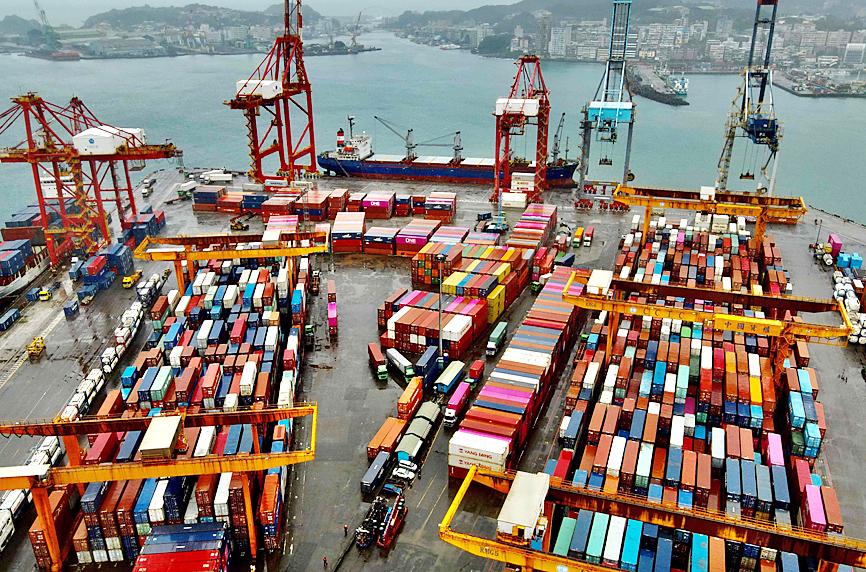The government’s business climate monitor last month signaled “green” for the fourth straight month as the nation’s economic recovery held firm, thanks to robust demand for both tech and non-tech products, the National Development Council said yesterday.
The gauge gained two points to 30, the highest in nine-and-a-half years, and was set to climb higher this month, the council said.
“The latest data suggest that the recovery is not only stable, but will gain further traction,” council research director Wu Ming-huei (吳明蕙) told a media briefing in Taipei.

Photo: Sam Yeh, AFP
The council uses a five-color system to portray the nation’s economic state, with “green” indicating steady growth, “red” suggesting overheating and “blue” signaling a recession. Dual colors mean it is in transition.
The gauge is only two points away from the boom values of 32 to 37, aided by better manufacturing, restaurant and retail sales, the council said.
The remaining constituents stayed in a healthy zone.
Wu said that the monitor might signal “yellow-red” this month, as there is cause for pessimism, based on the trends of all economic bellwethers.
Demand for 5G wireless communication and new technology applications remained strong, while non-tech products showed signs of rebounding, explaining why most sectors reported an upturn in business, Wu said.
The annual “Singles’ Day” shopping season that culminated on Nov. 11 helped boost retail sales in Taiwan, she said.
The index of leading indicators, which aims to forecast the economic situation for the next six months, increased 1.41 percent to 107.45, as all sub-indices registered positive cyclical movements, the report said.
That suggests that recovery is broad-based, rather than being limited to tech sectors as previously, Wu said.
The index of coincident indicators, which reflects the current economic state, gained 1.16 percent to 104.21, also drawing support from all sub-indices, the report showed.
Despite the improvement, the COVID-19 pandemic would continue to pose uncertainty for the global economy next year, Wu said.
If the pandemic escalates in Europe and the US, Taiwan cannot stay immune given its heavy dependence on exports, she added.
Separately yesterday, the council set its economic growth target for Taiwan next year at 3.8 percent to 4.2 percent, driven mainly by growth in external demand, private consumption and domestic investment.
The high end of the council’s growth target is just more than the 3.83 percent the Directorate-General of Budget, Accounting and Statistics forecast on Nov. 27.
The council also expects the nation’s GDP per capita next year to be between US$30,038 and US$30,145, the consumer price index to rise by 1 to 1.5 percent and the unemployment rate to be 3.6 to 3.8 percent, according to a statement on its Web site.

JITTERS: Nexperia has a 20 percent market share for chips powering simpler features such as window controls, and changing supply chains could take years European carmakers are looking into ways to scratch components made with parts from China, spooked by deepening geopolitical spats playing out through chipmaker Nexperia BV and Beijing’s export controls on rare earths. To protect operations from trade ructions, several automakers are pushing major suppliers to find permanent alternatives to Chinese semiconductors, people familiar with the matter said. The industry is considering broader changes to its supply chain to adapt to shifting geopolitics, Europe’s main suppliers lobby CLEPA head Matthias Zink said. “We had some indications already — questions like: ‘How can you supply me without this dependency on China?’” Zink, who also

Taiwan Semiconductor Manufacturing Co (TSMC, 台積電) received about NT$147 billion (US$4.71 billion) in subsidies from the US, Japanese, German and Chinese governments over the past two years for its global expansion. Financial data compiled by the world’s largest contract chipmaker showed the company secured NT$4.77 billion in subsidies from the governments in the third quarter, bringing the total for the first three quarters of the year to about NT$71.9 billion. Along with the NT$75.16 billion in financial aid TSMC received last year, the chipmaker obtained NT$147 billion in subsidies in almost two years, the data showed. The subsidies received by its subsidiaries —

At least US$50 million for the freedom of an Emirati sheikh: That is the king’s ransom paid two weeks ago to militants linked to al-Qaeda who are pushing to topple the Malian government and impose Islamic law. Alongside a crippling fuel blockade, the Group for the Support of Islam and Muslims (JNIM) has made kidnapping wealthy foreigners for a ransom a pillar of its strategy of “economic jihad.” Its goal: Oust the junta, which has struggled to contain Mali’s decade-long insurgency since taking power following back-to-back coups in 2020 and 2021, by scaring away investors and paralyzing the west African country’s economy.

The number of Taiwanese working in the US rose to a record high of 137,000 last year, driven largely by Taiwan Semiconductor Manufacturing Co’s (TSMC, 台積電) rapid overseas expansion, according to government data released yesterday. A total of 666,000 Taiwanese nationals were employed abroad last year, an increase of 45,000 from 2023 and the highest level since the COVID-19 pandemic, data from the Directorate-General of Budget, Accounting and Statistics (DGBAS) showed. Overseas employment had steadily increased between 2009 and 2019, peaking at 739,000, before plunging to 319,000 in 2021 amid US-China trade tensions, global supply chain shifts, reshoring by Taiwanese companies and